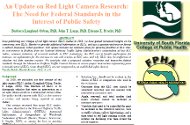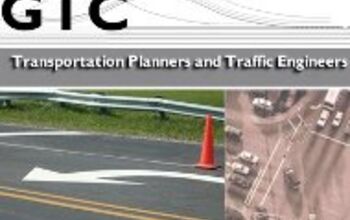Report Critiques Red Light Camera Research Methods
A peer-reviewed article published Wednesday in the Florida Public Health Review elaborated on a previous analysis of methods used in certain red light camera studies. University of South Florida (USF) researchers Barbara Langland-Orban, Etienne E. Pracht and John T. Large returned to clarify certain points raised in response to their 2008 report that concluded red light cameras tended to increase injury accidents ( view study).
“In our original critique, we faulted the research methods used in the Federal Highway Administration’s (FHWA) analysis titled Safety Evaluation of Red-Light Cameras,” the USF report stated. “One FHWA official subsequently contacted us to point out that we overlooked an important finding: fatal crashes at red light camera sites had increased, yet were ignored in the related economic analysis.”
Earlier this month, the Insurance Institute for Highway Safety (IIHS) generated a significant amount of positive publicity for red light cameras by claiming red light cameras caused a reduction in fatal accidents ( view report). The more rigorous FHWA study found that 0.5 percent of angle crashes were fatal in the “before” period without red light cameras. After cameras were installed, the figure grew to 0.8 percent. The FHWA study concluded there was a financial benefit from crash reductions due to the use of cameras, but only because the FHWA chose to exclude fatal accidents from their estimates. USF re-calculated the FHWA numbers including fatalities to find that red light camera use resulted in a net loss of $17,360 per intersection in estimated accident costs, according to the FHWA methodology.
The USF researchers took issue with the design of the FHWA study, but the greatest criticism was reserved for the “unscientific” studies performed by the IIHS and the Cochrane Collaboration. Both of these works drew sweeping conclusions from a simple before and after comparison that did not control for variables such as traffic volume, long-term accident trends and intersection geometry that could affect the results.
“The studies that integrated relevant independent variables in the analysis found red light cameras were associated with increases in crashes and injuries,” the report stated ( view rigorous studies). “This reveals the complexity of conducting public health research because an outcome can be incorrectly attributed to an intervention if variables necessary to explain the outcome are excluded.”
The USF researchers explained that red light cameras may increase injury accidents because most red light running accidents are the result of unintentional mistakes. For example, a driver is distracted and did not notice that the light was red, causing a collision. The presence of a camera would not have altered the outcome because if the signal itself was missed, it is not likely the camera would be noticed.
“Understanding root causes of red light running crashes (e.g., intentional versus unintentional infractions, driving under the influence, or traffic signal or intersection defects) is necessary to advance remedies that are specific to the problem,” the report stated. “In contrast, red light camera advocates presume red light running crashes occur from willful red light running.”
The report concluded that federal standards should be established to require engineering analysis before the installation of red light cameras. It also recommends full transparency in the reporting of accident data at red light camera locations.
A copy of the analysis is available in a 90k PDF file at the source link below.
Update on Red Light Camera Research (Florida Public Health Review, 2/23/2011)
[Courtesy: Thenewspaper.com]
More by The Newspaper
Latest Car Reviews
Read moreLatest Product Reviews
Read moreRecent Comments
- AZFelix What could possibly go wrong with putting your life in the robotic hands of precision crafted and expertly programmed machinery?
- Orange260z I'm facing the "tire aging out" issue as well - the Conti ECS on my 911 have 2017 date codes but have lots (likely >70%) tread remaining. The tires have spent quite little time in the sun, as the car has become a garage queen and has likely had ~10K kms put on in the last 5 years. I did notice that they were getting harder last year, as the car pushes more in corners and the back end breaks loose under heavy acceleration. I'll have to do a careful inspection for cracks when I get the car out for the summer in the coming weeks.
- VoGhost Interesting comments. Back in reality, AV is already here, and the experience to date has been that AV is far safer than most drivers. But I guess your "news" didn't tell you that, for some reason.
- Doc423 Come try to take it, Pal. Environmental Whacko.
- 28-Cars-Later Mazda despite attractive styling has resale issues - 'Yota is always the answer.


































Comments
Join the conversation
The red light cameras are a scam. Originally, traffic laws had safety as their goal. Thus, there were certain minimum yellow light durations - the higher the speed limit, the longer they would be. Cities, insofar as they use these devices, are putting revenues over safety. Red light violations and accidents decline as yellow light durations increase. When a California city increased yellow light duration from 3 seconds to 4, violations declined from 10 to 1.3 per day. These cameras require a dangerously short yellow to make any money - without it, they are unprofitable, and removed shortly thereafter. There is a wealth of information about the flaws of red light cameras and traffic laws in general, how safety and efficiency are decidedly not the guiding principles behind traffic regulations. Source: http://www.thenewspaper.com/news/31/3110.asp
NO! We need more red light cameras and less yellow times at all intersections so that the municipality that installs them can make up for all the wasteful non-budgetary spending that occurs and all of the ridiculous pay raises that government managers get at the expense of the people like the well won't run dry! WE NEED MORE RED LIGHT CAMERAS!!!!! INSTALL THEM NAOOOOO!!!!!! (escapes from straitjacket) MORE RED LIGHT CAMERAS!!!!!!!!!!!!! (close-up of watery drippy nostril)